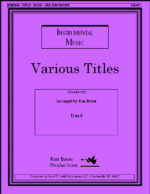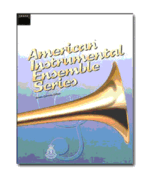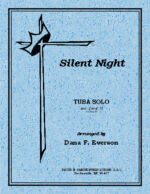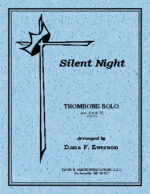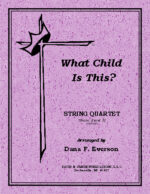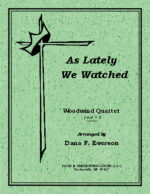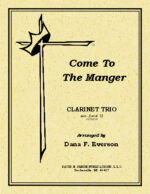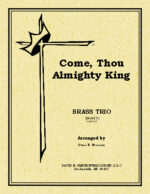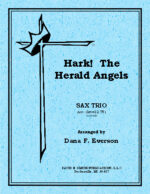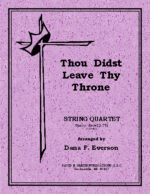-
-
Sweet Little Jesus Boy (F/Eb solo)
$9.95Often mistaken as a traditional spiritual, “Sweet Little Jesus Boy” was composed in 1934 by Robert MacGimsey who intentionally wrote the song in this style. It harkened back to his youth in Louisiana where he was steeped in the deep tradition of African American gospel music. In this culture, Christmas was a time to draw closer to God through personal prayer and meaningful songs, which was a stark contrast to what he observed in New York when he penned the song.
Written during the depression, “Sweet Little Jesus Boy” quickly became a standard Christmas tune, along with several other songs written at this time. Recorded by many artists over the years, the soulful recording by Mahalia Jackson in 1955 is perhaps the most famous.
-
Sweet Little Jesus Boy (F/Eb solo)
$29.95Often mistaken as a traditional spiritual, “Sweet Little Jesus Boy” was composed in 1934 by Robert MacGimsey who intentionally wrote the song in this style. It harkened back to his youth in Louisiana where he was steeped in the deep tradition of African American gospel music. In this culture, Christmas was a time to draw closer to God through personal prayer and meaningful songs, which was a stark contrast to what he observed in New York when he penned the song.
Written during the depression, “Sweet Little Jesus Boy” quickly became a standard Christmas tune, along with several other songs written at this time. Recorded by many artists over the years, the soulful recording by Mahalia Jackson in 1955 is perhaps the most famous.
-
Hear The Angels Sing
$29.95This bright, up-tempo march is based on two melodies for the carol “It Came upon a Midnight Clear” – “Noel” by Arthur Sullivan (1874) and “Carol” by Richard Willis (1850). These words, written by Edmund Sears in 1849, beautifully describe the scene when the angels declared to the world that a savior had been born.
-
Scherzo on “In Dulci Jubilo”
$29.95This short Scherzo is based on the German folk tune “In Dulci Jubilo,” to which we sing “Good Christian Men Rejoice.” It will bring a smile to your face as we consider the joy that only Christ can bring!
-
Silent Night
$4.50An accompanied tuba solo that begins with a gentle piano introduction. The soloist then presents the tune with subtle modifications. The second section progresses with even greater melodic enhancement. With a modulation the solo deviates the melody with an almost obbligato-like fashion. With further modulation the solo line gravitates to a style reminiscent to the second section. The coda section is patterned after the first section and then settles down to sweet silence.
-
Silent Night
$4.50An accompanied trombone solo that begins with a gentle piano introduction. The soloist then presents the tune with subtle modifications. The second section progresses with even greater melodic enhancement. With a modulation the solo deviates the melody with an almost obbligato-like fashion. With further modulation the solo line gravitates to a style reminiscent to the second section. The coda section is patterned after the first section and then settles down to sweet silence.
-
Silent Night
$4.50An accompanied trumpet solo that begins with a gentle piano introduction. The soloist then presents the tune with subtle modifications. The second section progresses with even greater melodic enhancement. With a modulation the solo deviates the melody with an almost obbligato-like fashion. With further modulation the solo line gravitates to a style reminiscent to the second section. The coda section is patterned after the first section and then settles down to sweet silence.
-
What Child Is This?
$10.50A string quartet with optional third violin for viola. After a brief introduction the theme is presented in a straight forward ensemble harmonization with some altered pitches. The next section places the melody in the viola line with opposing lines in the violins. The ensuing section now gives the tune to the second violin with contrapuntal action in the other voices. A chorus section is now more articulated and active until the tune is handed to the first violin with ever more moving counterpoint in the other voices. The piece then ends in a strong statement.
-
As Lately We Watched
$11.00A woodwind quartet with optional parts is presented in a joyful manner giving a sense of expectation. After a pert introduction, the melody is stated with a solo clarinet with answering figures rotated amongst the other voices. A joyful bridge section gravitates towards a modulation with the tune stated in the lower voices. The piece goes into a free, flourishing motion where it heads into yet another modulation. The tune now is doubled in the flute and clarinet with accompaniment figures moving in hemiola sets. After a set of imitation figures passed about the ensemble the piece goes into a coda section with more joyful figures.
-
Come To The Manger
$8.00An accompanied sax trio (A-A-A/T) opening with an exciting motive. The first rendition is in block harmonies with occasional rhythmic punctuations. The next section has subtle contrapuntal statements amongst all parts giving a joyous texture. After a modulation the ensemble alternates between solo statements and full ensemble giving contrasts in texture and color. Another modulation ensues where imitative motives take place through the voices only to come together in a solid fashion for an exciting ending.
-
Come To The Manger
$8.00An accompanied clarinet trio opening with an exciting motive. The first rendition is in block harmonies with occasional rhythmic punctuations. The next section has subtle contrapuntal statements amongst all parts giving a joyous texture. After a modulation the ensemble alternates between solo statements and full ensemble giving contrasts in texture and color. Another modulation ensues where imitative motives take place through the voices only to come together in a solid fashion for an exciting ending.
-
Come Thou Almighty King
$10.00An accompanied brass trio for trumpet, horn (trumpet) and trombone (baritone horn TC). The piece begins with a motive that is imitative and builds in intensity until the theme is presented in the trombone with punctuations from the upper voices. It continues much in this manner until the chorus erupts in block harmonies. After a modulation and meter change, the trio presents a fanfare style until it abruptly reverts to the original meter. And then a more solemn manner, all the while gaining strength until a conclusive ending.
-
Hark The Herald Angels Sing
$8.00An accompanied saxophone trio for altos and optional tenor. The piece begins in a lively fashion starting quietly and adding more parts as it crescendos up to the opening of the tune in full ensemble scoring. The chorus passes active melodic portions amongst the parts until it flairs up to a triumphal statement. After a modulation the theme is passed around in a hocket-like fashion and then explodes into a block set of harmonies adding more and more rhythmic movement. The concluding section uses multiple dynamic and rhythmic shifts to cause contrasts up to a resounding conclusion
-
Thou Didst Leave Thy Throne
$9.00A string quartet with optional violin for viola. After a full ensemble introduction the piece gives way to a duet in the viola and cello. With the violins entering one at a time the piece now becomes full with all parts present gravitating to motivic development moving to a modulation. The next section gives the tune to the cello with the upper lines adding punctuated accompanied figures. The next section uses motivic patterns while passing portions of the tune to the various players. A modulation- then the parts become increasingly more active in a variation style. With a solid ensemble altering the melody; a brake; then, repose.
-
-
-
-
-
-
-
-
-

